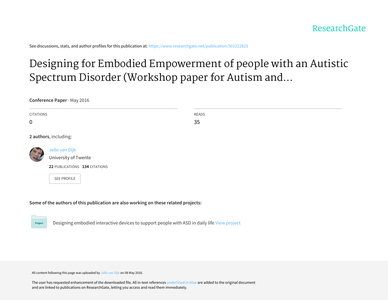Workshop paper Taking an embodied perspective, we report on the design of two interactive products aimed at empowering people with an Autistic Spectrum Disorder in coping with challenges of everyday life. Our Research-through-Design study combined theory with hands-on co-design work and in situ user observation, in close collaboration with clients and their professional caretakers, constructing experienceable prototypes as tangible anchors for reflection. Reflection resulted in guiding principles addressing the design potential of designing for Embodied Empowerment, centering on the client’s embodied-being-in-the-world.
DOCUMENT

To reach for abstraction is a major but challenging goal in mathematics education: teachers struggle with finding ways how to foster abstraction in their classes. To shed light on this issue for the case of geometry education, we align theoretical perspectives on embodied learning and abstraction with practical perspectives from in-service teachers. We focus on the teaching and learning of realistic geometry, not only because this domain is apt for sensori-motor action investigations, but also because abstraction in realistic geometry is under-researched in relation to other domains of mathematics, and teachers’ knowledge of geometry and confidence in teaching it lag behind. The following research question will be addressed: how can a theoretical embodied perspective on abstraction in geometry education in the higher grades of primary school inform current teacher practices? To answer this question, we carried out a literature study and an interview study with in-service teachers (n = 6). As a result of the literature study, we consider embodied abstraction in geometry as a process of reflecting on, describing, explaining, and structuring of sensory-motor actions in the experienced world through developing and using mathematical artifacts. The results from the interview study show that teachers are potentially prepared for using aspects of embodied learning (e.g., manipulatives), but are not aware of the different aspects of enactment that may invite students’ abstraction. We conclude that theories on embodiment and abstraction do not suffice to foster students’ abstraction process in geometry. Instead, teachers’ knowledge of embodied abstraction in geometry and how to foster this grows with experience in enactment, and with the discovery that cognition emerges to serve action.
LINK
Recently several attempts were undertaken to unite the field of metaphor studies, trying to reconcile the conceptual/cognition and linguistic/discourse approaches to metaphor (Hampe, 2017b). The dynamic view of metaphor espoused by amongst others Gibbs (2017a) as a way to unify the field of metaphor studies is said to converge on findings and theoretical predictions found in cognition and discourse approaches. The author argues this focus on dynamical models to explain the multi-scale socio-cognitive aspects of metaphor as an emergent phenomenon is not robust enough. Complexity and dynamical systems are merely a modelling technique to deploy theory for empirical testing of hypotheses; a dynamic view of metaphor needs a coherent background theory to base its dynamic modelling of metaphor in action on (Chemero, 2009). I argue that it can be successfully based on the ecological-enactive framework available within the modern paradigm of 4E cognitive science. This framework makes possible explanation of both 'lower' cognition and 'higher' cognition emerging in the interaction of an organism with its environment. In addition, I sketch how recent theoretical insights from ecological-enactivism (Baggs and Chemero, 2018) concerning Gibson's notion of environment apply to the attempted unification of the field of metaphor studies. I close by suggesting how an understanding of metaphor as an ecological affordance of the socio-cultural environment can provide a rich basis for empirical hypotheses within a dynamical science of metaphor.
LINK